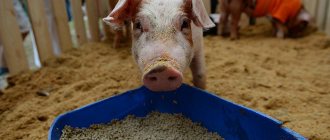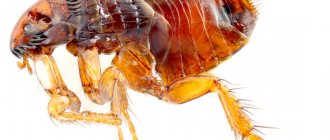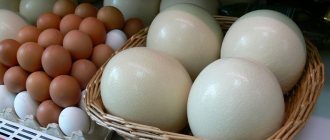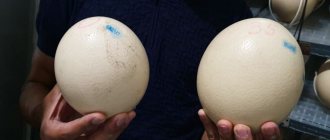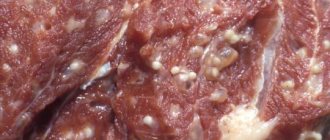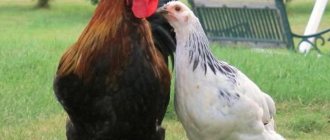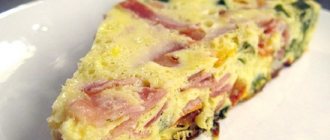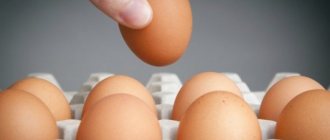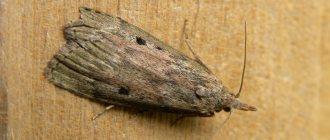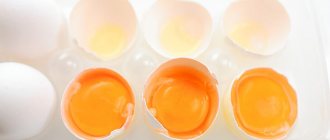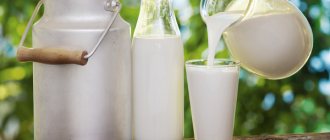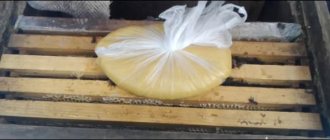If you think that you have already tried everything and nothing will surprise you. Durian is your favorite fruit, but chicken feet are not a delicacy for you. What about hundred year old egg?
And although it is not a hundred years old, it looks one hundred percent! The persistent smell and rich taste are complemented by the amber color of the protein, which together entices you to enjoy this unusual Chinese delicacy. Despite the fact that Chinese cuisine is not to everyone’s taste, the century-old egg is still worth trying for yourself, or at least treating a friend. But let's not reveal all the cards at once, let's start in order.
Delicacy “Chinese eggs” - what is it?
This traditional Chinese snack is also called “hundred-year-old eggs.” To a person ignorant of oriental cuisine, it will seem more than original. The appetizer is made from bird eggs - chicken or duck. After special processing, eggs acquire a special color, taste and smell.
The snack was nicknamed “Century Eggs” due to its unusually long shelf life. But this is not the most unusual quality of a Chinese dish. The main “highlight” of the snack is its dark color and unpleasant smell, for which Europeans often call this delicacy “rotten eggs.”
According to American television, they are “the most terrible delicacy.” China was outraged by this statement and demanded an official apology from the television company.
You don’t have to go to China to buy “hundred-year-old eggs”, because you can buy them in Russia. The cost of a package of 6 eggs ranges from 600-1000 rubles.
Nutritional value of 100 g of “black eggs”:
- calorie content – 133 kcal;
- fats – 5 g;
- proteins – 13 g;
- carbohydrates – 8 g.
In China, this original delicacy is very popular. The Chinese respectfully call it “imperial eggs.” In other countries, this exotic dish does not cause much delight. Gourmets and simply curious people are interested in it.
Traditional names for century eggs from China
In the country, this delicacy is called 皮蛋 in Pinyin (the sound in English is pidan, i.e. pidan), canned eggs, century eggs, thousand-year eggs, millennium egg.
During the process of canning (this is done using special techniques), small crystalline patterns appear on the black protein, generally reminiscent of a pine branch, which gave rise to another name - songhuadan (songhua - translated from traditional Chinese as "pine flowers", dan - translated as " egg"), a pine-patterned egg. These same eggs are called imperial, or Ming Dynasty eggs.
History of the dish
There are several versions about the origin of the “black eggs”. According to one of them, initially there was no talk of any delicacy. The eggs were covered with alkaline clay to extend their shelf life. Over time, the need for original “preservation” disappeared, and the traditional snack migrated to the category of delicacies.
According to the second version, the method of preparing eggs was discovered completely by accident - 600 years ago, one Chinese discovered several eggs in slaked lime left over from whitewashing. For some reason he tried them, and he unexpectedly liked the taste. He cooked himself a few more eggs, adding salt to the lime.
Traditional name for Chinese eggs
In China, delicacy eggs are called pinyin. In English it sounds like pidan. The name translates as hundred-year-old or thousand-year-old eggs.
The second name is Songhuadan. This snack was awarded for the small pattern on the squirrel, reminiscent of a pine branch. Literally, “songhua” is translated as “pine color”, and dan means “egg”.
What does a Chinese rotten egg look like?
Color and consistency of hundred-year-old eggs:
- The protein is brown, glassy-elastic. Almost transparent.
- The yolk is creamy, gray-green or almost black with a green tint.
The outer surface of the protein adjacent to the shell is covered with “frosty patterns.”
How do they look?
Due to this, the yolk becomes dark green or gray in color and has a creamy consistency and strong aroma due to the presence of hydrogen sulfide and ammonia, and the white becomes dark brown and looks like a translucent jelly with a salty taste. The transforming substance in a century egg is an alkaline salt, which gradually increases the pH of the egg to approximately 9-12. This chemical process breaks down some of the complex, tasteless proteins and fats, and the process creates many smaller flavorful compounds.
Some century eggs have patterns near the surface of the egg white that resemble pine branches, giving rise to one of its Chinese names, "pine egg."
Method of preparing the delicacy
In China, there are several ways to prepare this popular delicacy. Among them, two main methods can be distinguished - traditional and modern. They differ in the nuances of technology, but the taste of the resulting snacks is approximately the same.
Traditional
The appetizer is usually prepared from duck or chicken eggs, rarely from quail eggs. The Chinese still cook “rotten eggs” according to ancient recipes. New technologies are used if they want to speed up the process.
To prepare the snack according to the traditional recipe, you will need the following ingredients:
- clay;
- ash of burnt oak;
- sea salt;
- calcium oxide.
How to prepare a delicacy according to an ancient recipe:
- Dissolve tea in hot water.
- Add all the prepared ingredients to the resulting liquid.
- Mix thoroughly and wait for the paste to thicken.
- Coat the eggs with the resulting mixture, and then roll them in straw and rice husks.
- Place the eggs in a basket and bury them in the ground. Here they should lie for 1-2 months.
To avoid chemical burns, all manipulations must be carried out with gloves.
Modern
The modern method involves soaking raw eggs in various chemicals. In particular, a solution of table salt, sodium carbonate and others are used. Eggs are soaked in the solution for 10 days. Then they are removed and coated in clay. Wrapped in film, they are left to “ripen” in the solution for several weeks.
When preparing “rotten eggs,” the main thing is to create an airless environment. For this purpose, they are buried in the ground or wrapped in film.
There are thousands of recipes for making this popular Chinese delicacy. They differ in nuances, but their essence is the same - being in an alkaline environment without air access.
Methods
The traditional method of producing century eggs is an evolution and improvement of the above-mentioned primitive process. Instead of using clay alone, a mixture of wood ash, calcium oxide and salt is added to the preservative mixture, thereby increasing the pH and sodium content. Adding calcium oxide and wood ash to the mixture reduces the risk of spoilage and also increases the speed of the fermentation process.
The recipe for creating a hundred-year egg begins with pouring one and a half liters of tea into boiling water. To this add 1.5 kg of calcium oxide, 3 kg of sea salt and 3 kg of burnt oak ash, which are mixed to a thick paste. Gloves are then worn (to prevent the chemicals from getting on your skin) and each egg is individually coated with the mixture by hand and then rolled in rice husks.
After this, the blanks are placed in fabric-covered jars or tightly woven baskets. The mixture dries slowly into a crust over several months, after which the eggs are ready to eat.
What is Pidan and Songhuadan today?
In China, there are not only special traditions of preparing pidan and sunhuadan, accumulated over thousands of years. The Celestial Empire also has official technologies, documented and patented, which confirm the quality and identity of an authentic delicacy.
Thousand-year-old eggs can be purchased:
- In shops. The product prepared by the food industry is sold in foam containers. They contain eggs, peeled from the outer layer. The consumer can only peel them from the shell.
- In the markets. Along with official products, there are many century-old eggs in Chinese markets, prepared in an artisanal way according to ancient traditional recipes.
Safety
Heavy metals are used to speed up the process, make more profit in less time, and artificially improve the quality of canned eggs. This was an unscrupulous practice in some small factories, but it became widespread in China and forced many honest manufacturers to label their boxes “lead-free” after the scandal went viral in 2013. Nanchang County used industrial grade copper sulfate which was contaminated with arsenic, lead, cadmium, as well as other heavy metals and toxic chemicals, which make the eggs more transparent, reduce odor, provide a smoother texture and promote faster curing.[10][11 ] The Chinese government has been trying for years to regulate food additives and license law-abiding businesses to combat food safety incidents in China due to poor manufacturing practices.
What does the delicacy taste like?
It is difficult to describe the taste of the Chinese delicacy, because it has no analogues in European cuisine. There is simply nothing to compare the original taste of black eggs with. But they smell similar to some cleaning products.
We can only describe its individual parts:
- Protein is almost tasteless. There is an opinion that its taste and consistency resembles elastic jellied meat with a taste of some kind of “chemistry”.
- The yolk actively smells of ammonia and hydrogen sulfide. It is a little runny, the taste and consistency resembles some kind of cream.
The only way to know the taste of black eggs is to buy them and try them. True, if you read reviews on the Internet beforehand, the desire to eat the famous delicacy will most likely disappear.
How to eat and what to serve this delicacy with?
To eat a hundred-year-old egg, it must be shelled. Before doing this, you need to make sure that there is no damage to it. If the shell is chipped or cracked, the egg is considered spoiled.
The peeled egg should not be held in your hands. It should be placed on a plate for about 15 minutes. During this time, the smell of ammonia will disappear a little from it. Then the egg is cut into 4 parts and eaten.
“The most terrible delicacy” can be enjoyed without a side dish, or it can be served with something more familiar to the taste of Europeans.
Suitable side dish:
- tofu;
- rice water;
- pork;
- fresh salads.
In China, the delicacy is never served alone. Eggs cut into pieces are usually poured with soy sauce with the addition of ginger. In Chinese restaurants they are often served mixed with boiled rice.
The more refined and dense the patterns on the “thousand-year egg”, the higher its quality.
What determines the condition of hair?
The condition of hair is influenced by many factors: poor nutrition, pregnancy, aggressive environmental influences, scorching sun, dry air.
Stress and improper care also damage hair and make it brittle, unruly and dull. Unlike, for example, skin, they are not able to regenerate on their own, and if the hair is also weak by nature, it definitely requires outside help. Ways to restore a healthy look to your hair
You need to use so-called scanning complexes. A therapeutic complex with wheat protein quickly and effectively restores hair. The product is applied 2-3 times a week to damp hair and not washed off, after which it becomes elastic and easy to comb. The problem of split ends is solved by a balm with Austrian walnut oil. It returns vitality and softness to them.
Aloe vera and mango have moisturizing properties. To quickly treat hair, you need to use emulsion creams with biologically active substances, amino acids, provitamins, minerals and antioxidants. Such emulsions have an antimicrobial, anti-inflammatory effect, improve blood microcirculation in the scalp, regenerate and nourish hair follicles. Apply them to wet hair for a few minutes and rinse thoroughly.
Emulsions help strengthen the hair structure along the entire length, prolong its life cycle and improve its appearance. There are special ampoules for hair that are used after washing. They are quite easy to use and give good results. What is the difference between hair treatment creams and hair masks?
Creams are suitable for preventing the disease.
They are applied for 3-5 minutes to damp hair. Masks take longer. They are left on the hair for 30 minutes. Masks cope well with such acute problems as hair loss, severe damage after coloring, protect hair from negative influences, and have regenerating properties. Wrapping gives good results. Hydrotherapy with fruit wax capsules effectively moisturizes hair, which protects it from drying out and damage. Selection of hair detergents.
Hair must be washed as it gets dirty.
The main thing is to choose the right shampoo. It should be soft, gentle and suitable for daily use. The packaging of high-quality shampoo always indicates the frequency of its use. For example, there are products that you can use to wash your hair only once a week. These are special cleansing shampoos with strong ingredients. They free the hair from residues of cosmetic products, such as fixatives, varnishes, wax, etc. Which shampoo is most suitable for thin hair
It all depends on your hair type.
They can be thin but oily, dry or oily at the roots but dry at the ends. In general, strengthening and so-called thickening shampoos with marine proteins containing placenta are suitable for fine hair of all types. The placenta is a source of natural proteins that give strength to fine hair and make it voluminous along its entire length. They greatly weigh down thin hair and “two-in-one” shampoos are not suitable for them. It’s good to use intensive cleaning products with vitamins and amino acids once a week. Don't forget about calcium shampoos. Calcium penetrates the hair structure and effectively restores it. Shampoos with silk proteins also increase the volume of fine hair. What is the best water for washing your hair
? Clean water that does not contain harmful impurities. But not everyone can afford to buy such water. It is necessary to use shampoos based on glucosides and pH-neutral. They make washing soft in water of any hardness and do not irritate the scalp. Such shampoos are indispensable for chlorinated tap water. You need to pay attention to the acidity level of the shampoo - it should not dry out the protective layer of the scalp too much. Shampoos based on pure water are safe and pleasant to use. What products to use for fine and oily hair
Oily hair needs special care.
For them, it is better to choose drugs and shampoos that reduce excess secretion of the sebaceous glands. This is, first of all, herbal medicine. Shampoos with extracts of horsetail, St. John's wort, oak bark, burdock roots, sage, linden, birch, and yarrow perfectly degrease hair, eliminate hypersecretion of the sebaceous glands, restore the lipid balance of the scalp and hair without destroying their structure or drying it out. What is special about caring for dry hair?
Dry hair requires products with a strengthening and moisturizing effect. B vitamins nourish, vitamin C is very useful for weakened hair, the keratin complex strengthens and gives volume to hair. Ceramides restore dry and brittle hair. Among herbal shampoos, products with nettle, calamus, plantain, string, and oregano are recommended.
It is very good to rub special oils into the roots of your hair - corn, coconut, paraffin and others - once every two weeks. The oil soothes, effectively eliminates dandruff and is indispensable for dry scalp and brittle hair. Rub it into the scalp for 20-30 minutes and then rinse thoroughly. If you are extremely dry, it is better to heat the oil and put on an insulating cap after applying it. To prevent the appearance of dandruff, you can use shampoos with a strong bactericidal effect, containing a new product - piroctone olamine - and sulfur extracts. How to properly care for thin mixed hair
Products for this type of hair should perform two main healing functions: firstly, cope with oiliness at the roots, and secondly, intensively moisturize dry ends. Now there are many products designed for mixed hair types. These are special double-action complexes with microsubstances. They nourish hair and remove sebum at the roots. Shampoos with seaweed concentrate provide intensive care for combination hair. Which conditioners are most suitable for thin hair?
These are lightweight products that do not weigh down your hair. Rinses with provitamins are highly effective. They restore and strengthen hair from the inside. Carotene adds volume and silkiness. Balms with chitosan remove electrostatic charge. Bio-balms based on kefir whey, which contains bioactive compounds and microelements that strengthen the roots and stimulate metabolic processes in the scalp, restore a healthy appearance to the hair. Betaine gives volume to hair.
Balms with betaine should be applied to the hair for 2-3 minutes, and then be sure to rinse off. Lipid rinses protect hair from harmful environmental influences. Special conditioners with panthenol are designed to thicken them. They saturate the hair with nutrients, restore water balance and give it elasticity and density. Such conditioners should be rubbed into damp hair and rinsed off after a few minutes. Strengthening hair cream-masks with ceramides and multivitamins give good results. They should be left on the hair for three minutes and then washed off with warm water. What is aromatherapy
This is an individual approach to choosing shampoo using essential oils.
To create any fragrance in a detergent, you need to choose the right base, which must match your hair type. How to choose styling products. What are the features of drying fine hair?
Can you blow dry them? You need to learn how to dry your hair in a way that doesn't cause harm to it. The hairdryer should be kept at a distance of 30-40 cm from the head, the heat should be medium, not too hot. To make your hair look voluminous, you first need to dry your hair a little with a hairdryer, lifting it at the roots.
For long-lasting styling, choose a special product and apply it at the roots, and not along the entire length. Give the strands the desired shape using attachments and a hair dryer. To create volume, you can use large Velcro curlers, wind them onto slightly damp hair after applying foam, dry them with a hairdryer and secure with a fixative. The hairstyle is voluminous and retains its shape for a long time. You can use attachments with so-called “fingers”. They lift thin hair at the very roots and thus make it voluminous. What styling products are suitable for thin hair?
Foams or liquid gel are especially effective for this type of hair. They give the hairstyle pomp and volume. Hair mousse is also very good, which should be applied only to damp hair. Hair styling spray also helps create artistic chaos on your head. Restores hair density with volume spray.
It dries instantly, allowing you to style your hair quickly. Spray volume spray onto damp and dry hair. Spray conditioners with proteins improve the structure of keratin fibers. They seem to envelop each hair, protect and significantly increase volume. The conditioner should be shaken well before use and applied to dry and damp hair. And don’t wash it off! It can be used frequently, as needed. Can I use wax to style my hair?
Unfortunately, it is not very suitable for thin hair.
Especially if they are oily at the roots. The wax itself is too greasy and heavy. It is best used for modeling hairstyles with thick and thick hair. Although, if the haircut is very short and the hair is not prone to excess oiliness, a small amount of wax can be used. It is rubbed in your hands and applied to the roots with your fingers. The main thing is not to overdo it! The same applies to gels. Wax and gel must be washed off at night. Thin hair doesn't hold its shape well.
What fixatives are best to use after styling ? Fixers only secure the hairstyle and provide additional stability. There are two techniques here - application and spraying. For tall, complex hairstyles, first of all you need to use hairspray. Hairspray with elastses holds the hairstyle perfectly and makes the hair elastic. Hairsprays with silk proteins restore hair and prevent it from sticking.
They are sprayed onto dry hair, at the very roots, at a distance of 10-15 cm from the hair, slightly lifting the strands. There is no need to spray hairspray on damp hair; it will be sticky and stiff, creating the feeling of an impenetrable helmet on your head. The gel more gently secures the shape of the styling. With its help you can simulate individual curls.
It is best to apply the gel with your fingers, laying each strand separately. Spray gels that are sprayed onto the hair roots are very convenient. Foam varnish with super strong hold significantly increases the volume of the hairstyle and fixes it. Foams are applied only to slightly damp hair, dried with a hairdryer. And one more thing: when buying foams, you need to pay attention to their composition. The more alcohol they contain, the more they dry out your hair. This, by the way, applies to gels, mousses, and modeling creams.
Information sources:
- kak-ya.ru - thin, dull hair. Diet, cosmetics, products for thin, dull hair.
- vitaminov.net - care for thin hair.
Recipes for preparing the delicacy at home
There are many recipes for making “thousand-year eggs.” In combination with sauces and side dishes, their taste takes on a new meaning.
Shanghai style
To prepare “hundred-year-old eggs” in Shanghai, you will need the following ingredients:
- 2 pidan eggs;
- 0.5 tbsp. l. Sahara;
- 2 tbsp. l. soy sauce.
Step-by-step instruction:
- Wash the eggs and peel the shells.
- Place the eggs on a plate and cut into 8 pieces. The Chinese usually cut it into 4 pieces, but Europeans find it easier to eat thinner slices. When cutting, use the thinnest knife possible, as this will best cut through the buttery-creamy consistency of the yolk.
- Arrange the cuts beautifully on a plate.
- Pour the sauce over the slices and sprinkle with sugar.
Serve the dish cold or warm, as you prefer. Boiled rice can be used as a side dish.
Nordic or European style
For this recipe you will need the following ingredients:
- 3-4 pidan eggs;
- 0.5 kg bean curd (tofu cheese);
- 1 tsp. sesame oil;
- 1 tbsp. l. soy sauce;
- monosodium glutamate - to taste (flavor enhancer added as desired).
Step-by-step instruction:
- Wash the eggs and peel the shells.
- Cut them on a flat plate into 8 pieces.
- Drain the brine from the cheese. Cut it into 1x1 cm cubes. Rinse with cold water to drain all the brine.
- Place the chopped eggs in a bowl and stir in the tofu cubes.
- Pour soy sauce over the mixture. Add sesame oil and serve.
see also
- Food portal
- Chinese portal
- Balut (food) - A developing bird embryo, boiled and eaten from the shell
- Iron egg - an egg dish from Taiwan
- Pickled egg - Hard-boiled eggs baked in vinegar or brine
- Salted duck egg
- Smoked Egg - Food involving smoking eggs
- Soy egg
- Tea egg is a Chinese savory food usually sold as a snack.
- Chinese red eggs
- Virgin Boy Egg - Traditional dish of Dongyang, Zhejiang, China
